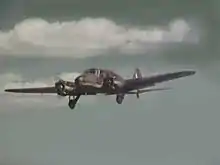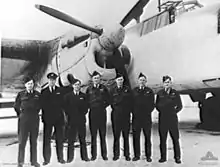No. 612 Squadron RAF
No. 612 Squadron RAF was originally formed in 1937 as an Army Co-operation unit, and flew during the Second World War in the General Reconnaissance role. After the war the squadron was reformed and flew in the Day Fighter role until disbanded in 1957. At present the squadron has a non-flying role as a RAF Medical Reserves unit.
| No. 612 (County of Aberdeen) Squadron RAF | |
|---|---|
| Active | 1 June 1937 – 9 July 1945 10 May 1946 – 10 March 1957 1997 – present |
| Country | |
| Branch | |
| Role | RAF Medical Reserves |
| Part of | Royal Auxiliary Air Force |
| Base | Leuchars Station |
| Motto(s) | Latin: Vigilando Custodimus (Translation: "We stand guard by vigilance")[1][2] |
| Commanders | |
| Honorary Air Commodore | Sir Ian Forbes-Leith (48–57) Finlay Crerar (57-present) |
| Insignia | |
| Squadron Badge heraldry | In front of a trident and a harpoon in saltire a thistle dipped and leaved The trident and harpoon point to the squadrons anti-submarine role, while the thistle signifies its ties with Aberdeen[1][2] |
| Squadron Codes | DJ (Jul 1939 – Sep 1939)[3] WL (Sep 1939 – Aug 1943)[4] 8W (Jul 1944 – Jul 1945, 1949 – Apr 1951)[5] RAS (May 1946 – 1949)[6] |
History
Formation and early years

No. 612 Squadron RAF was formed on 1 June 1937 at RAF Dyce as an army co-operation unit of the Auxiliary Air Force and was initially equipped with two-seat Avro Tutor training aircraft. In December 1937 it had received two-seat Hawker Hector Army co-operation aircraft, which were retained when the squadron converted from the Army Co-operation to the General Reconnaissance role. In July 1939 the squadron received Avro Ansons which had room for four crew members and had a much better range, making them better suited for the reconnaissance role.
Second World War: on Whitleys and Wellingtons
No. 612 squadron entered the Second World War as a maritime reconnaissance ("General Reconnaissance") unit within RAF Coastal Command, flying with the Avro Ansons. These were replaced from November 1940 with Armstrong Whitworth Whitleys, and from November 1942 on these made again gradually (April 1943 saw the last Whitley leave the squadron) way for various marks of specially adapted General Reconnaissance (GR) versions of the Vickers Wellington, which the squadron continued to fly until the end of the war. The squadron disbanded on 9 July 1945 at RAF Langham.

Post-war: on Spitfires and Vampires
No. 612 squadron was reformed on 10 May 1946 at RAF Dyce as a fighter squadron of the Royal Auxiliary Air Force. Initially the squadron was equipped with Griffon-engined Spitfire F.14s and in November 1948 it got additional Merlin-engined Spitfire LF.16e fighters.[2][7] It converted to de Havilland Vampire FB.5s in June 1951, flying these first from RAF Leuchars and later from RAF Edzell and, when the runway was extended, again from RAF Dyce until disbandment on 10 March 1957, on the same day as all other flying units of the RAuxAF.
Present: field surgical support
The squadron was reformed in 1997 at RAF Leuchars from The Air Transportable Surgical Squadron, and maintained that units role of field surgical support. In 2001 the squadron had its first operational role in support of Operation Saif Sareea II, an exercise in Oman. Over a hundred military personnel were treated, mainly for heat-related injuries. In 2003 the squadron was first mobilised for support in a combat zone, in support of Operation TELIC. Squadron members were deployed to Kuwait and Cyprus and finally worked at field hospitals in Basra and Al Ahmara in Iraq. In 2006 No. 612 squadron was again mobilised to support operations in Iraq and was deployed to the field hospital at Shaibah Logistic Base (SLB). Thereafter, the Sqn continued to deploy dedicated medical specialists to augment the Military Hospital and the MERT at Camp Bastion in Afghanistan, earning admiration and commendations for their work. The Sqn continues to train and deploy as required and has now built up an outstanding relationship during 2017-2018 with a USAF Reserve Medical Sqn, which allows for multi-national training. No 612 Sqn goes from strength to strength !
Commanding Officers since reformation of No 612 (County of Aberdeen) Sqn at RAF Leuchars (now Leuchars Station) in 1997
| 1997 | 2001 | Wg Cdr J Curnow |
| 2001 | 2003 | Wg Cdr H Grant |
| 2003 | 2007 | Wg Cdr W Pugsley |
| 2007 | 2011 | Wg Cdr A M Moodie OBE QVRM AE |
| 2011 | 2014 | Wg Cdr J P Goodall |
| 2014 | 2018 | Wg Cdr A Cowan |
| 2018 | to date | Wg Cdr B M Colligan TD VR |
Aircraft operated
| From | To | Aircraft | Version |
|---|---|---|---|
| June 1937 | December 1937 | Avro Tutor | |
| December 1937 | November 1939 | Hawker Hector | Mk.I |
| July 1939 | November 1941 | Avro Anson | Mk.I |
| November 1940 | December 1941 | Armstrong Whitworth Whitley | Mk.V |
| May 1941 | June 1943 | Armstrong Whitworth Whitley | GR.Mk.VII |
| November 1942 | February 1943 | Vickers Wellington | GR.Mk.VIII |
| May 1943 | June 1943 | Vickers Wellington | GR.Mk.XII |
| June 1943 | July 1945 | Vickers Wellington | GR.Mk.XIV |
| November 1946 | October 1949 | Supermarine Spitfire | F.14 |
| November 1948 | July 1951 | Supermarine Spitfire | LF.16e |
| June 1951 | March 1957 | de Havilland Vampire | FB.5 |
Squadron bases
| From | To | Base | Remark |
|---|---|---|---|
| 1 June 1937 | 1 April 1941 | RAF Dyce, Aberdeenshire, Scotland | (Dets. at RAF Bircham Newton, RAF Stornoway, RAF Wick) |
| 1 April 1941 | 15 December 1941 | RAF Wick, Caithness, Scotland | (Dets. at RAF Limavady, RAF St Eval, RAF Reykjavik) |
| 15 December 1941 | 18 August 1942 | RAF Reykjavik, Iceland | (Det. at RAF St Eval) |
| 18 August 1942 | 23 September 1942 | RAF Thorney Island, West Sussex | (Dets. at RAF Wick, RAf St Eval) |
| 23 September 1942 | 18 April 1943 | RAF Wick, Caithness, Scotland | (Dets. at RAF St Eval, RAF Skitten) |
| 18 April 1943 | 25 May 1943 | RAF Davidstow Moor, Cornwall | |
| 25 May 1943 | 1 November 1943 | RAF Chivenor, Devon | (Det. at RAF Davidstow Moor) |
| 1 November 1943 | 3 December 1943 | RAF St Eval, Cornwall | |
| 3 December 1943 | 26 January 1944 | RAF Chivenor, Devon | |
| 26 January 1944 | 1 March 1944 | RAF Limavady, County Londonderry, Northern Ireland | |
| 1 March 1944 | 9 September 1944 | RAF Chivenor, Devon | (Det. at RAF Limavady) |
| 9 September 1944 | 19 December 1944 | RAF Limavady, County Londonderry, Northern Ireland | |
| 19 December 1944 | 9 July 1945 | RAF Langham, Norfolk | |
| 10 MAy 1946 | 14 July 1951 | RAF Dyce, Aberdeenshire, Scotland | |
| 14 July 1951 | 14 October 1951 | RAF Leuchars, Fife, Scotland | |
| 14 October 1951 | 12 November 1952 | RAF Edzell, Angus, Scotland | |
| 12 November 1952 | 10 March 1957 | RAF Dyce, Aberdeenshire, Scotland | |
| 1997 | RAF Leuchars, Fife, Scotland | 2014 Now an Army Base - Leuchars Station where No 612 Sqn are still based |
Commanding officers-1937-1957
| From | To | Name |
|---|---|---|
| June 1937 | June 1940 | W/Cdr. F. Crerar |
| June 1940 | July 1941 | W/Cdr. J.B.M. Wallis |
| July 1941 | January 1942 | W/Cdr. D.R. Shore |
| January 1942 | July 1942 | W/Cdr. R.T. Corry |
| July 1942 | April 1943 | W/Cdr. R.M. Longmore, CBE |
| April 1943 | June 1943 | W/Cdr. J.S. Kendrick |
| June 1943 | January 1944 | W/Cdr. J.B. Russell, DSO |
| January 1944 | February 1945 | W/Cdr. D./M. Brass, DSO |
| February 1945 | May 1945 | W/Cdr. A.M. Taylor |
| May 1945 | July 1945 | W/Cdr. G. Henderson |
| November 1946 | August 1948 | S/Ldr. R.R. Russell |
| August 1948 | September 1948 | S/Ldr. Child |
| October 1948 | S/Ldr. Webb | |
| November 1950 | December 1952 | S/Ldr. Guy W. Cory, AFC |
| December 1952 | S/Ldr. Nigel H.McLean | |
| 1955 | 1957 | S/Ldr. T.E. Johnston, Distinguished Flying Cross (United Kingdom)DFC |
| February 1957 | March 1957 | Flt Lt R Robertson |
References
Notes
- Rawlings 1982, p. 237.
- Halley 1988, p. 429.
- Bowyer & Rawlings 1979, p. 14.
- Bowyer & Rawlings 1979, p. 109.
- Bowyer & Rawlings 1979, p. 113.
- Bowyer & Rawlings 1979, p. 138.
- Rawlings 1978, p. 501.
- Rawlings 1982, p. 238.
- Jefford 2001, p. 101.
- Hunt 1972, pp. 339–340.
- 612 Sqn RAuxAF ORB, TNA AIR 27/2518 & 27/2676
Bibliography
- Bowyer, Michael J.F.; Rawlings, John D.R. (1979). Squadron Codes, 1937–56. Cambridge, UK: Patrick Stephens Ltd. ISBN 0-85059-364-6.
- Flintham, Vic; Thomas, Andrew (2003). Combat Codes: A Full Explanation and Listing of British, Commonwealth and Allied Air Force Unit Codes since 1938. Shrewsbury, Shropshire, UK: Airlife Publishing Ltd. ISBN 1-84037-281-8.
- Halley, James J. (1988). The Squadrons of the Royal Air Force & Commonwealth, 1918–1988. Tonbridge, Kent, UK: Air-Britain (Historians) Ltd. ISBN 0-85130-164-9.
- Hunt, Leslie (1972). Twenty-One Squadrons: The History of the Royal Auxiliary Air Force, 1925–1957. London: Garnstone Press. ISBN 0-85511-110-0.
- Jefford, C.G. (2001). RAF Squadrons, a Comprehensive record of the Movement and Equipment of all RAF Squadrons and their Antecedents since 1912 (2nd ed.). Shrewsbury, Shropshire, UK: Airlife Publishing Ltd. ISBN 1-85310-053-6.
- Rawlings, John D.R. (1982). Coastal, Support and Special Squadrons of the RAF and their Aircraft. London: Jane's Publishing Company Ltd. ISBN 0-7106-0187-5.
- Rawlings, John (1978) [1969]. Fighter Squadrons of the RAF and their Aircraft (revised ed.). London: Macdonald and Jane's Publishers Ltd. ISBN 0-354-01028-X.
External links
| Wikimedia Commons has media related to No. 612 Squadron RAF. |

